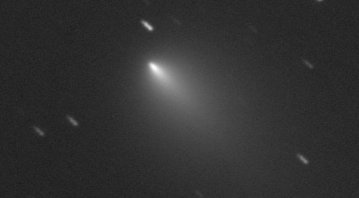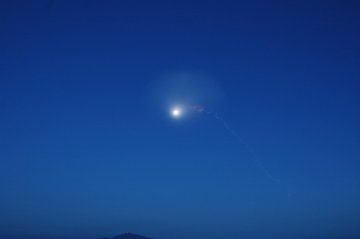 Did you sleep through the auroras? Next time get a wake-up call. Sign up for Spaceweather PHONE.
Did you sleep through the auroras? Next time get a wake-up call. Sign up for Spaceweather PHONE.
A PLANET NAMED GEORGE: This month Venus can lead you to a naked-eye planet that ancient astronomers inexplicably failed to notice. Get the full story from Science@NASA.
COMET NEWS: Astronomers are monitoring the many fragments of dying comet 73P/Schwassmann-Wachmann as it approaches Earth for a close encounter in May 2006. Two new developments: Fragment B is in an accelerated state of decay. The mini-comet has become elongated and no longer displays a central condensation, according to IAU Electronic Telegram No. 473. (continued below)

Above: Comet fragment 73P-B, photographed on April 11th by amateur astronomer Rolando Ligustri of Italy.
Pictured above, fragment B is glowing like a 9th magnitude star, making it an easy target for backyard telescopes and CCD cameras. Amateur astronomers can actually watch this comet fall apart: sky map, ephemeris.
Meanwhile, further along the "string of pearls," fragment G has also split. Fresh ice exposed by the disruption is vaporizing, causing the comet to brighten nearly 15-fold since April 2nd. With a visual magnitude of 12 (IAU Circular No. 8701), fragment G is more challenging for amateurs, but no less tempting: sky map, ephemeris.
DAWN SURPRISE: "Last Friday at dawn, the California coast was treated an interesting display," says Brian Webb of Ventura County. "Many people saw it, but didn't know what it was. The American Meteor Society's Bob Lunsford even received a couple of reports of a fireball." (continued below)

Above: "This photo is a good representation of what I saw with my eyes," says photographer Brian Webb. More: #1, #2.
"In reality it was the launch of a Minuteman III missile from Vandenberg Air Force Base," Webb explains. "Lift-off was originally set for 3:02 a.m. PDT, but technical problems delayed it until 6:00 a.m.. Although it was still twilight on the ground, the missile was high enough that the third stage exhaust plume was illuminated by sunlight and created a large, glowing orb against the dawn sky."

